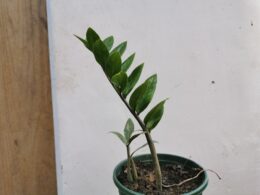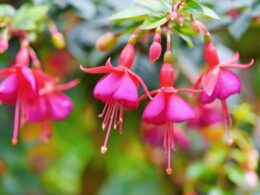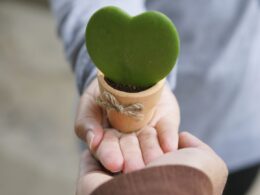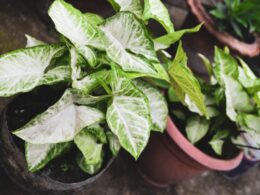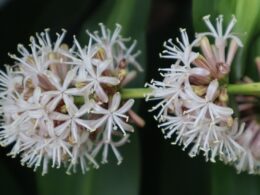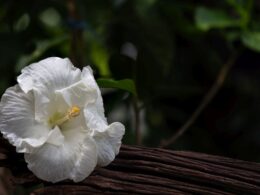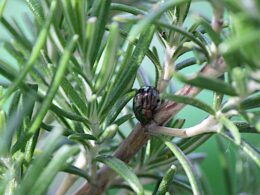What Is a Caladium Plant, and Where Does It Come From?
Before we jump into caladium plant care, let’s see what’s special about it. Caladium is a genus of plants native to South America and Central America. The most popular species is Caladium bicolor, sporting leaves that look as if they were painted. Common names for caladium include:
- elephant ear;
- heart of Jesus;
- angel wings.
Caladium is a tuberous plant, which means it grow from thickened, fleshy underground stems called tubers (or bulbs, colloquially speaking). These plants typically have large, heart-shaped or arrowhead-shaped leaves, and they come in a wide range of colors. The caladium plant is grown for its colorful foliage and is often used as a houseplant or annual bedding plant in cooler climates.
How to Grow Caladium from Bulbs?
Caladium plant care starts with planting it the right way! Plant your caladium bulbs in spring, after the last frost has passed. They need consistent temperatures of around 70 degrees Fahrenheit to sprout. For this reason, it’s easier to start them indoors before transplanting the plants into your garden.
These plants prefer well-drained, rich soil with a pH of 5.5 to 6.2. A mix of regular potting soil and peat moss will do the trick. Now, let’s get planting!
- Make holes for the bulbs, about 6-8 inches apart.
- Plant the tubers about 2 inches deep, with the ‘eyes’ facing upward.
- Water them from above right after planting.
- Continue watering regularly – only do it when the soil is dry on the surface.
- Wait 6-8 weeks for growth to appear.
- Once leaves have sprouted, you can move your plants outside in late spring.
Now, let’s go through some caladium plant care tips. Follow them, and your caladiums will thrive!
Caladium Plant Care – Fertilizer
These tropical plants will appreciate feeding every two weeks with a half-strength liquid fertilizer during their growing season – throughout spring and summer. Stop fertilizing in the fall, as caladiums go dormant then.
Caladium Plant Care – Watering
Caladiums like their soil moist but not soggy. Water them regularly, and make sure the soil drains well. They will suffer in drought conditions, so during periods of little rainfall, give them a good soaking about once per week. When the leaves die back in fall, stop watering the plant until next spring.
How Much Light Caladium Plants Need
These plants prefer partial shade, so they won’t do well in direct sunlight. How much light they can tolerate depends on how wide their leaves are – narrower leaves can withstand more sun.
Ideal Temperatures and Humidity for Caladium Plants
Caladiums are tropical plants and prefer warm, humid conditions. They will do best in temperatures of 70-85 degrees Fahrenheit during the day and 60-65 degrees at night. If the temperature gets any lower than 60 degrees Fahrenheit, caladium leaves will start to turn brown and die back.
Keep the air around your caladiums as humid as possible. You can increase the humidity by grouping plants together, using a pebble tray, or misting the leaves regularly.
Pruning Caladium Plants
Pruning is an optional part of caladium plant care, but you can snip off any brown or yellow leaves. Also, cut back the plant when it starts to fade in fall. This will help it stay healthy and produce more leaves next season.
How to Propagate Caladium Plants
Caladiums are typically replanted from their original bulbs, but you can also propagate them by dividing the caladium tubers. To do this, wait until the leaves have died back in fall.
- Carefully dig up the tubers and shake off any excess soil.
- Cut the tubers into pieces with a sharp and sterile tool, making sure each one has at least one ‘eye.’
- Allow the tuber sections to ‘heal’ for a week before planting.
- Plant the tuber pieces about two inches deep, with the ‘eye’ facing up.
Repotting Caladium Plants
These plants don’t need to be repotted often, but you may need to do it every year or two. This will protect their roots from sitting in water and rotting. The best time to repot caladiums is in spring, before they start putting out new growth.
Common Problems with Caladium Plants
Caladiums are generally trouble-free plants, but they can be susceptible to pests and diseases.
- Aphids, whiteflies, and mealybugs may attack caladiums. These pests can cause the leaves to yellow or brown. You can get rid of them by spraying the plants with water or using an insecticidal soap.
- Caladiums may also be affected by fungal diseases, such as leaf spot and botrytis. These can cause the leaves to turn brown or black and eventually die. To prevent fungal diseases, water caladiums at the base and don’t overcrowd them.
Caladium Plant Toxicity
Be aware that caladium plants are poisonous to people and animals if ingested. The toxins are found in all parts of the plant, but they’re most concentrated in the tuber. If you have pets or small children, it’s best to keep caladiums out of reach.
Now you know everything about caladium plant care! With a little attention, their curious foliage will brighten up any space in your home.










